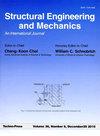考虑膜片挠性可能性的扭转结构地震反应
IF 3
4区 工程技术
Q2 ENGINEERING, CIVIL
引用次数: 0
摘要
由于其简单的应用,全刚性地板隔膜是广泛应用于常见实践的主要假设之一。然而,如果没有有限元建模,就无法轻松确定膜片柔性的确切程度,这是一个昂贵且耗时的过程。因此,根据抗震规范的规定限制,表面上刚性的隔膜在地震中总是有可能具有一定程度的灵活性。由于非对称平面结构中膜片挠性具有更多的不确定性,因此本文主要研究扭转约束结构中可能存在的楼板膜片挠性误差。本研究采用的分析模型为非对称平面的单层混凝土剪力墙结构。虽然没有明确考虑地板系统,但考虑的膜片灵活性范围很广,从完全刚性到相当柔性,使得结果可以推广到许多抗侧荷载系统以及地板系统。研究表明,除了先前已知的膜片柔性的影响外,在刚性膜片假设的设计过程中,正交侧元的存在以及其吸收力的迅速减少也可能是由于柔性而增加误差的重要来源。因此,根据所得结果,作者建议设计人员在其常见设计中考虑膜片挠曲的可能性及其不利影响,特别是在扭转约束系统中。本文章由计算机程序翻译,如有差异,请以英文原文为准。
Seismic response of torsional structures considering the possibility of diaphragm flexibility
Fully rigid floor diaphragm is one of the main assumptions that are widely used in common practices due to its simple application. However, determining the exact degree of diaphragms flexibility cannot be easily accomplished without finite element modeling, which is an expensive and time-consuming procedure. Therefore, it is always possible that apparently rigid diaphragms, based on prescriptive limitations of seismic codes, experience some degrees of flexibility during the earthquakes. Since diaphragm flexibility has more uncertainties in asymmetric-plan structures, this study focuses on errors resulting from probable floor diaphragm flexibility of torsionally restrained structures. The analytical models used in this study were single-story buildings with asymmetric plan and RC shear walls. Although floor system is not considered explicitly, a wide range of considered diaphragm flexibility, from fully rigid to quite flexible, allows the results to be generalizable to a lot of lateral load resisting systems as well as floor systems. It has been shown that in addition to previously known effects of diaphragm flexibility, presence of orthogonal side elements during design procedure with rigid diaphragm assumption and rapid reduction in their absorbed forces can also be an important source to increase errors due to flexibility. Accordingly, from the obtained results the authors suggest designers to consider the possibility of diaphragm flexibility and its adverse effects, especially in torsionally restrained systems in their common designs.
求助全文
通过发布文献求助,成功后即可免费获取论文全文。
去求助
来源期刊

Structural Engineering and Mechanics
工程技术-工程:机械
CiteScore
3.80
自引率
18.20%
发文量
0
审稿时长
11 months
期刊介绍:
The STRUCTURAL ENGINEERING AND MECHANICS, An International Journal, aims at: providing a major publication channel for structural engineering, wider distribution at more affordable subscription rates; faster reviewing and publication for manuscripts submitted; and a broad scope for wider participation.
The main subject of the Journal is structural engineering concerned with aspects of mechanics. Areas covered by the Journal include:
- Structural Mechanics
- Design of Civil, Building and Mechanical Structures
- Structural Optimization and Controls
- Structural Safety and Reliability
- New Structural Materials and Applications
- Effects of Wind, Earthquake and Wave Loadings on Structures
- Fluid-Structure and Soil-Structure Interactions
- AI Application and Expert Systems in Structural Engineering. Submission of papers from practicing engineers is particularly encouraged.
 求助内容:
求助内容: 应助结果提醒方式:
应助结果提醒方式:


